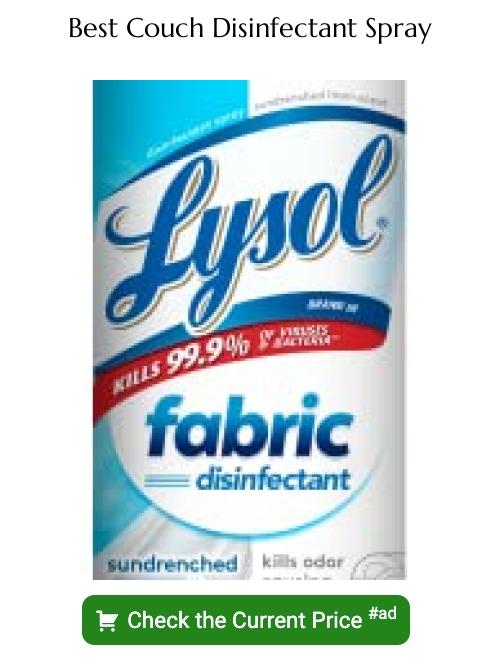Last updated on
In this guide, you’ll learn the process of effectively disinfecting a couch to ensure a clean and hygienic living environment.
Key takeaways:
- Vacuum the couch thoroughly for a deep clean.
- Check the couch’s tag for cleaning recommendations.
- Use a gentle dish soap solution for light stains.
- Disinfect with rubbing alcohol, but test on a small area first.
- Maintain a regular cleaning schedule to keep the couch fresh.
Table of Contents
Vacuum the Couch
Begin by thoroughly vacuuming all surfaces of your couch to remove dust, crumbs, and other debris. Use the brush attachment to gently scrub the fabric, ensuring that the vacuum does not damage the upholstery. Target the crevices and folds as dirt and germs tend to accumulate in these hard-to-reach areas.
Don’t forget to remove cushions and vacuum both sides, as well as the area underneath. Regular vacuuming not only prepares the couch for disinfection but also extends its life by preventing the build-up of grime that can degrade fabric fibers.
Check Your Couch’s Tag
Before proceeding with any cleaning agent, it’s crucial to determine the material of your couch and its manufacturer’s recommendations for cleaning. You’ll usually find a tag with codes indicating suitable cleaning practices:
- “W” means water-based cleaners are safe to use.
- “S” suggests that only solvent-based cleaners are appropriate.
- “WS” implies that both water-based and solvent cleaners are acceptable.
- “X” indicates that vacuuming or light brushing is recommended and that water or solvent cleaners should not be applied.
Adhering to these codes helps ensure that the cleaning process doesn’t harm your couch’s fabric or void any warranties. It’s always best to test any cleaner on a small, inconspicuous area first to check for any adverse reaction.
Prepare Mild Dish Soap Solution
Begin with a gentle, fabric-friendly solution to tackle light stains and give your couch a fresh feel without causing damage. Mix a few drops of liquid dish soap with warm water in a bowl until suds form. Dip a soft cloth into the bubbles—not directly into the water—to capture the soap without oversaturating the fabric.
Gently blot the surface of the couch, focusing on spots and stains. For a thorough clean, avoid scrubbing as this can damage fibers or cause discoloration. Work in sections to ensure even cleaning without missing spots. After treating an area, use a dry cloth to blot any excess moisture.
This approach is effective for many types of upholstery without introducing harsh chemicals.
Disinfect With Rubbing Alcohol
Rubbing alcohol, particularly a solution of at least 70% isopropyl alcohol, can be an effective disinfectant. To ensure your couch isn’t damaged by the alcohol, perform a spot test on an inconspicuous area. Once you’ve confirmed it won’t harm the fabric:
1. Transfer rubbing alcohol into a spray bottle.
2. Lightly mist the surface of the couch. Do not soak it.
3. Allow the alcohol to air dry. This step is crucial as it gives the alcohol time to kill germs.
4. If your couch material is particularly delicate, use a microfiber cloth lightly dampened with alcohol as an alternative. Gently wipe over high-touch areas.
Remember that well-ventilated spaces aid in the swift drying of alcohol and minimize the inhalation of fumes. Use caution on surfaces that can be damaged by alcohol, such as leather or some synthetics.
Maintain Regular Cleaning Schedule
To sustain a fresh and hygienic couch, integrate a cleaning routine into your weekly chores. Regular vacuuming not only removes crumbs and dust but also prevents the build-up of allergens. Use a soft brush attachment to protect the fabric while ensuring a thorough clean.
Attend to spills immediately by dabbing with a clean cloth; this prevents stains from setting in. Every month, take cushions outside and pat them to release trapped dust. If your couch has removable covers, launder them according to the manufacturer’s guidelines a few times a year. This proactive approach helps extend the life of your couch while ensuring it remains a clean, comfortable haven for your family.
FAQ
How do you sanitize a fabric couch?
To sanitize a fabric couch, mix 2 cups of rubbing alcohol with 1 cup of water in a spray bottle, ensure the bottle is in the mist setting by testing on another piece of fabric or sink, and spray this mixture after removing the seat and back cushions from the sofa.
How do you disinfect a couch after being sick?
Disinfecting a couch after illness can be effectively done by applying a disinfectant spray with a minimum of 90% alcohol content or one containing low hydrogen peroxide, allowing the solution to sit for 10 minutes before use.
How do you get bacteria out of a couch?
To get bacteria out of a couch, use a product such as Clorox’s Hydrogen Peroxide Cleaner & Disinfectant, which is available as both a spray for fabrics and a wipe for hard surfaces, as it can effectively kill pathogens, eliminating bacteria and viruses within 30 seconds.
What are the best couch disinfecting products available on the market?
The best couch disinfecting products on the market include Lysol Disinfectant Spray, Purell Multi-Surface Disinfectant, and Force of Nature Non-Toxic Natural Cleaner.
Can a leather couch be disinfected without damaging its quality?
Yes, a leather couch can be disinfected without damaging its quality using specific cleaners designed for leather or a mild soap and water mixture.
How often should you sanitize your couch to maintain hygiene standards?
To maintain hygiene standards, you should sanitize your couch at least once every three to six months.





